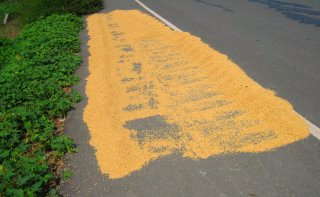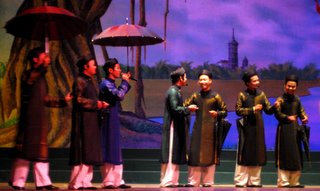 I was fortunate to arrive in time to witness the fall rice harvest. Rice is harvested twice yearly, in the spring and in the fall. First, rice is tied in bunches, then pulled out of the ground. After harvesting, the husks are separated from the reeds through a variety of methods. In a later photo, I will show you a man using a spinning barrel full of nail-like structures that does this separation process. After the husks are separated, they are dried alongside the road in the hot sun. After drying, the husks, or chaff, are separated to reveal the actual rice grain inside. Don't worry if you bite into a rock when eating unprocessed brown rice---it's likely not road pebbles and may be a piece of clean soil---we need the mineral supplements, anyway! The rice you see here is usually sustenance rations for local families or barter.
I was fortunate to arrive in time to witness the fall rice harvest. Rice is harvested twice yearly, in the spring and in the fall. First, rice is tied in bunches, then pulled out of the ground. After harvesting, the husks are separated from the reeds through a variety of methods. In a later photo, I will show you a man using a spinning barrel full of nail-like structures that does this separation process. After the husks are separated, they are dried alongside the road in the hot sun. After drying, the husks, or chaff, are separated to reveal the actual rice grain inside. Don't worry if you bite into a rock when eating unprocessed brown rice---it's likely not road pebbles and may be a piece of clean soil---we need the mineral supplements, anyway! The rice you see here is usually sustenance rations for local families or barter. A herd of cattle grazing with a tropical thunderhead streaming in the background....the transition from the rainy period was now shifting to the north part of the country, away from the Mekong. But later, did I find out that this tropical pitch, was in fact, a tendril of Typhoon Kai-Tak, which hit the central part of the country a few days later! These tropical clouds were moving to the west with such speed, rotating the equatorial pull as it began the Coriolis Effect in the jetstream. It was fun to watch them pass by; this particular one boiled westward like smoke from a huge fire miles away. Gratefully, in all the three days we biked, we either missed them within a mile or less or hit briefly during our lunch break. The evenings were always accentuated with lightning in the yonder horizon. Beautiful.
A herd of cattle grazing with a tropical thunderhead streaming in the background....the transition from the rainy period was now shifting to the north part of the country, away from the Mekong. But later, did I find out that this tropical pitch, was in fact, a tendril of Typhoon Kai-Tak, which hit the central part of the country a few days later! These tropical clouds were moving to the west with such speed, rotating the equatorial pull as it began the Coriolis Effect in the jetstream. It was fun to watch them pass by; this particular one boiled westward like smoke from a huge fire miles away. Gratefully, in all the three days we biked, we either missed them within a mile or less or hit briefly during our lunch break. The evenings were always accentuated with lightning in the yonder horizon. Beautiful.
Self-portrait just before we started....
Vietnam: Day 4; October 25th ---First day of Mekong River Delta bike tour
So! We set off on very nice, shiny red bikes, and immediately, I knew I was going to be okay. After a week of worrying about not being fit enough to bike 40ish miles per day for three days, the ease and grade of the road, combined with the captivating beauty of the scenery made me forget and just let go....
The following photos will be very self explanatory and I will keep my copy to a minimum (...I think!)


